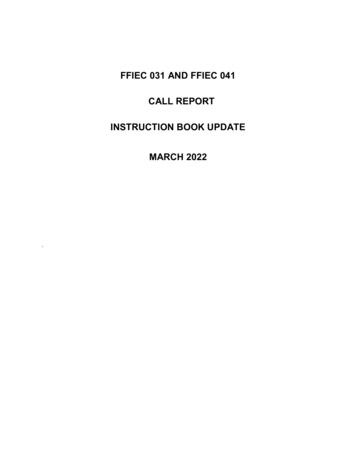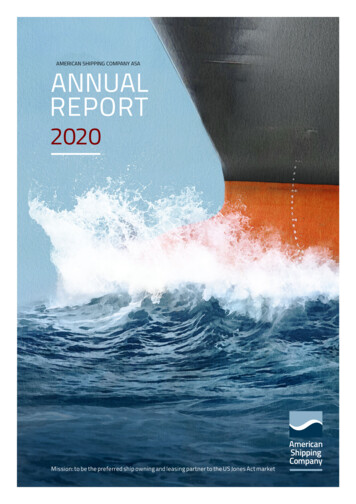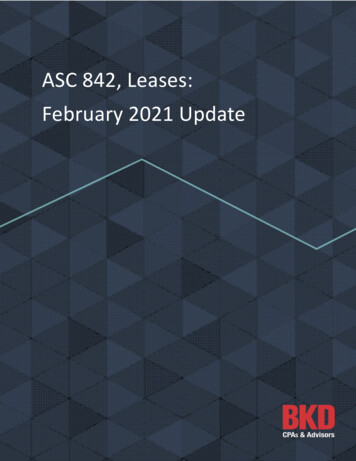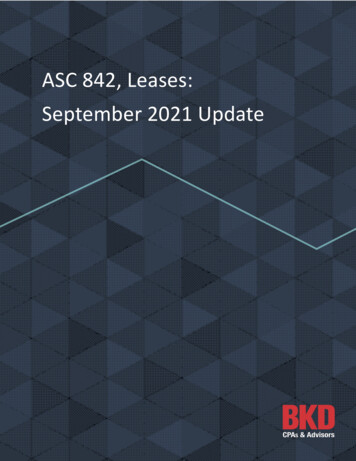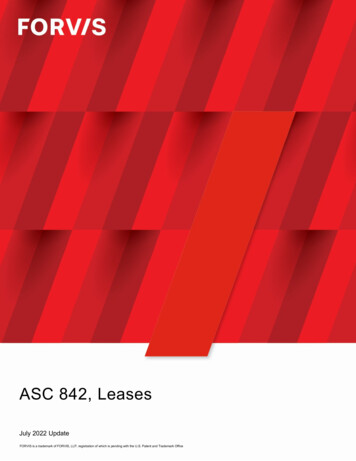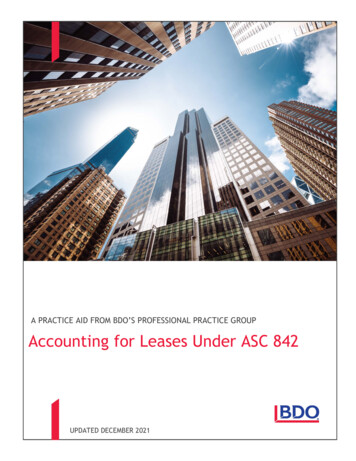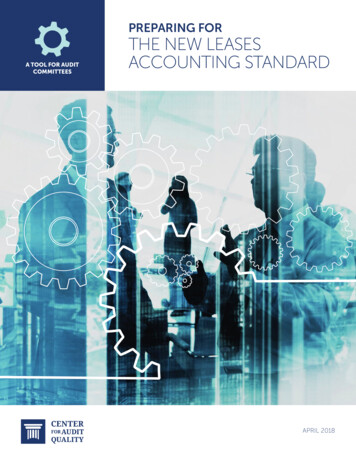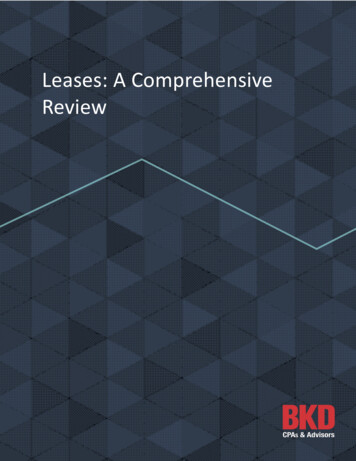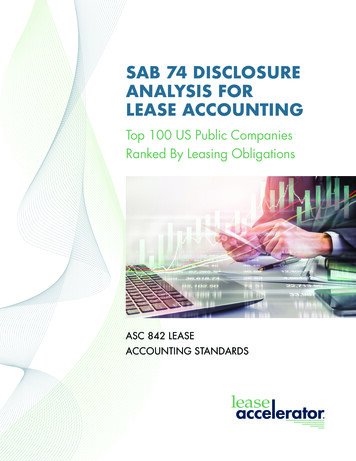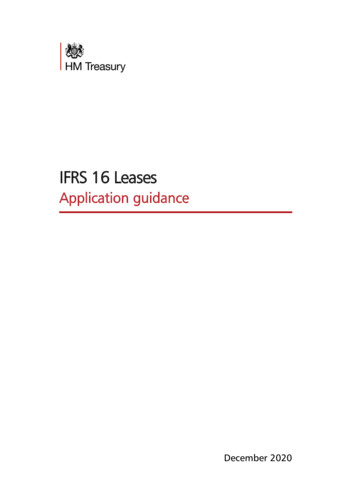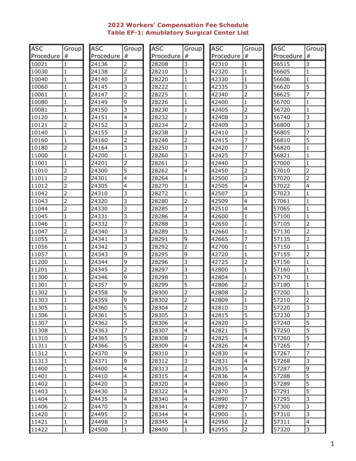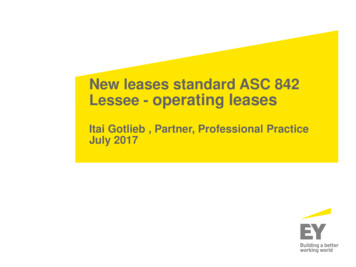
Transcription
New leases standard ASC 842Lessee - operating leasesItai Gotlieb , Partner, Professional PracticeJuly 2017
Overview Under Accounting Standards Codification (ASC) 842, Leases, lesseesrecognize assets and liabilities for most leases but recognizeexpenses in a manner similar to today’s accounting (ASC 840,Leases).All entities classify leases to determine how to recognize leaserelated expenses.The new guidance could have broad implications for entities’ financesand operations.Implementing the standard could require an entity to develop newprocesses and controls or adjust existing ones to identify and accountfor leases.Effective date For public companies - annual periods beginning after 15December 2018 (i.e., 1 January 2019 for a calendar-year entity),and interim periods within those years.Page 2New leases standard
Overview (cont.) Securities and Exchange Commission (SEC) Staff Accounting BulletinTopic 11.M (SAB 74) requires registrants to disclose the effect thestandard is expected to have on their financial statements. If a registrant does not know or cannot reasonably estimate theeffect, it should make a statement to that effect and considerproviding qualitative disclosures to help users assess thesignificance of the effect on the financial statements (ASC 250-10S99-6).The International Accounting Standards Board issued a similarstandard, but there are significant differences (e.g., under IFRS,lessees don’t classify leases).Page 3New leases standard
Scope and scope exceptionsGeneralThe guidance applies to: Leases of property, plant and equipmentThe guidance does not apply to: Leases of inventory intangible assets assets under construction and biological assets, including timberArrangements in the scope of ASC 853, Service ConcessionArrangementsA lease is a contract, or part of a contract, that conveys the right to controlthe use of identified property, plant or equipment (an identified asset) for aperiod of time in exchange for consideration.Page 4New leases standard
Scope and scope exceptionsDetermining whether an arrangement contains a lease (cont.) An identified asset can be: Implicitly or explicitly specified in a contract A physically distinct portion of a larger asset (e.g., a floor of a building) A capacity portion of a larger asset that represents substantially all the capacity ofthat assetThere is no identified asset if the supplier has a substantive substitution right.A substitution right is substantive when both of the following conditions are met: The supplier has the practical ability to substitute alternative assets throughout theperiod of use. The supplier would benefit economically from the exercise of its right to substitutethe asset.An entity evaluates whether a supplier’s substitution right is substantivebased on the facts and circumstances at inception of the contract. Page 5An entity should not consider future events that are not likely to occur.New leases standard
Scope and scope exceptions (cont.) Some agreements to be considered related to Technologyindustry: Data center agreements Outsourcing agreements Supply contractsPage 6New leases standard
Scope and scope exceptionsIdentifying and separating lease and non-lease components (cont.) Many contracts contain a lease coupled with an agreement to purchase orsell other goods or services (non-lease components). Non-lease components (e.g., maintenance activities, including common areamaintenance) are identified and accounted for separately from the lease componentin accordance with other US GAAP.Some contracts contain items that do not relate to the transfer of goods orservices by the lessor to the lessee (e.g., fees or other administrative coststhat a lessor charges a lessee, payments for insurance that protects thelessor’s asset, taxes related to the lessor’s asset). These items should not be considered separate components. Lessees and lessors do not allocate consideration in the contract to these items.Lessees can make an accounting policy election (by class of underlyingasset) to account for each separate lease component of a contract and itsassociated non-lease components as a single lease component.Page 7New leases standard
Key conceptsLease term and purchase optionsLease termAny noncancelable periodsPeriods covered by an option to extend the leaseif the lessee is reasonably certain to exercise that optionPeriods covered by an option to terminate the lease if the lessee isreasonably certain not to exercise that optionPeriods covered by an option to extend (or not terminate) the leasein which the exercise of the option is controlled by the lessor The FASB said that “reasonably certain” has the same meaning as“reasonably assured” in ASC 840. Reasonably certain is generally interpreted as a high threshold.Purchase options should be assessed in the same way as options to extendthe lease term or terminate the lease.Page 8New leases standard
Key conceptsLease payments Lease payments should be consistent with the lease term.Lease paymentsFixed (includingin-substancefixed) payments,less any leaseincentives paidor payable to thelesseeVariablepaymentsbased on anindex or rateExercise price ofa purchaseoption*Payments forpenalties forterminating thelease*** Include only if reasonably certain of exercise** Include only if the lease term reflects the lessee exercising an option to terminate the leasePage 9New leases standardAmounts it isprobable that thelessee will oweunder residualvalue guarantees(lessees only)
Key conceptsInitial direct costs (“IDCs“) Lessees and lessors apply the same definition of IDCsIDCs are costs that would not have been incurred if the lease had notbeen obtained. Examples include: CommissionsPayments made to an existing tenant as an incentive to terminate theleaseThe following are examples of costs that do not qualify as IDCs(i.e., costs that are not incremental): Page 10Allocation of general overhead (e.g., salaries, depreciation)Costs related to activities that occur before the lease is obtained(e.g., negotiating costs, legal advice)New leases standard
Lease classificationCriteria for lease classification – lesseesAt the commencement date, a lease is a finance lease if it meets anyone of the criteria below; otherwise the lease is an operating lease. The lease transfers ownership of the underlying asset to the lessee by theend of the lease term.The lease grants the lessee an option to purchase the underlying asset thatthe lessee is reasonably certain to exercise.The lease term is for the major part of the remaining economic life of theunderlying asset*.The present value of the sum of the lease payments and any residual valueguaranteed by the lessee that is not already reflected in the lease paymentsequals or exceeds substantially all of the fair value of the underlying asset.The underlying asset is of such a specialized nature that it is expected tohave no alternative use to the lessor at the end of lease term.* Not applicable for leases that commence at or near the end of the underlying asset’s economic lifePage 11New leases standard
Reassessment and remeasurementLease modifications and triggering event for reassessment: Triggering event for reassessment of lease classification Lease modification Lease modificationA change to the terms and conditions of a contract that results in a change in thescope of or the consideration for a lease (for example, a change to the termsand conditions of the contracts that adds or terminates the right to use one ormore underlying assets or extends or shortens the contractual lease term) If a lease is modified, lessees and lessors evaluate the modified contract todetermine whether it is or contains a lease.A lease modification can result in either: Page 12A separate contract (i.e., the unmodified original contract and a separate contract)A change in the accounting for the existing lease (i.e., not a separate contract)New leases standard
Lessee accountingRecognition and measurementOperating leasesFinance leases(1)Initial recognitionand measurementInitially measure the ROU asset and lease liability at the present value of thelease payments to be made over the lease termSubsequentmeasurement –lease liabilityMeasure the lease liability at thepresent value of remaining leasepayments using discount ratedetermined at lease commencement(2)Accrete the lease liability based on the interestmethod using the discount rate determined atlease commencement(2) and reduce the leaseliability by the payments madeSubsequentmeasurement –ROU assetMeasure the ROU asset at the amountof remeasured lease liability, adjustedfor the remaining balance of any leaseincentives received, any cumulativeprepaid or accrued rents (i.e., unevenrent payments), any unamortized IDCsand any impairment of the ROU assetAmortize the ROU asset, generally on astraight-line basis, over the shorter of thelease term or the useful life of the ROUasset, and record any impairment of theROU assetIncome statementeffectGenerally straight-line expenseGenerally “front-loaded” expenseInitial measurement of the ROU asset also includes the lessee’s IDCs and prepayments made to the lessor at or beforethe commencement date, less lease incentives received from the lessor(2) As long as the discount rate has not been updated as a result of a remeasurement event(1)Page 13New leases standard
Lessee accountingShort-term leases Lessees can make an accounting policy election, by class of underlying assetto which the right of use relates, to use the short-term lease exception. Applies to leases with a lease term of 12 months or less that do not include an optionto purchase the underlying asset that the lessee is reasonably certain to exercise Election can only be made at the commencement date Lessees do not recognize an ROU asset or lease liability for qualifying leases andrecognize lease payments as an expense on a straight-line basis Exception is not available for lessorsExample: noncancelable lease term of nine months with a four-month renewal option(assume no purchase option)1: Exercise of option is reasonably certain not short-term leaseNine monthsFour months2: Exercise of option is not reasonably certain short-term leaseNine monthsNoncancelable lease termPage 14New leases standardFour monthsOptional renewal period
Lessee accountingPresentation – balance sheetBalance sheetROU asset Present either separately ortogether with other assets(e.g., owned assets)If presented together with otherassets, disclose line items that includeROU assets and their amountsFinance lease ROU assets must bepresented separately from operatinglease ROU assetsSubject to same classification asother nonfinancial assetsPage 15New leases standardLease liability Present either separately or togetherwith other liabilitiesIf presented together with otherliabilities, disclose the line items thatinclude lease liabilities and theiramountsFinance lease liabilities must bepresented separately from operatinglease liabilitiesSubject to current and noncurrentclassification, similar to otherfinancial liabilities
Other considerationsSubleasesSubleaseA transaction in which an underlying asset is re-leased by the lessee(or intermediate lessor) to a third party (the sublessee), and the original(or head) lease between the lessor and the lessee remains in effectThe accounting for the original lease doesn’t change.LessorHead lease Sublease term may affect head lease classificationSublease classification is assessed independently of headlease Original lessee/sublessor Sublease Lessee/sublesseePage 16New leases standardConsider the underlying asset for classification purposes (ratherthan the ROU asset arising from the head lease)Use the discount rate of the head lease if the rate implicit in thelease cannot be readily determinedAdditional sublease disclosures are requiredLease classification is assessed in the same manner asany new lease Consider the underlying asset for classification purposes (ratherthan the ROU asset arising from the head lease)
ASC 842 LeasesImpact on lessee’s key performance indicators for operating leasesKPIsEffect of ASC 842 (operating leases)Gearing (Debt to Equity Ratio)Liabilities/EquityIncrease (because most leases previously accountedfor as operating leases will now be on balance sheet)EBITEarnings before interest and taxRemains unchanged (because lease expensecontinued to be reported in operating income onstraight-line basis)EBITDAEarnings before interest, tax andamortizationRemains unchanged (because lease expensecontinued to be reported in operating income onstraight-line basis)Operating cash flowRemains unchangedLeverageNet Debt/EBITDAIncrease (EBITDA remains unchanged while net debtwill increase)Page 17New leases standard
ASC 842 LeasesImpact on lessee’s economic decisions ASC 842 may effect the following: covenants Hedging transaction related to foreign exchange rates Purchase vs long-term operating lease Page 18Option to purchase underlying assetLeasehold improvementNew leases standard
ASC 842 LeasesImpact on lessee’s key performance indicators for operating leases vsfinance leaseKPIsEffect of ASC 842 (operatingleases)Effect of ASC 842(finance lease/acquisition with a loan)Gearing (Debt toEquity Ratio)Liabilities/EquityIncrease (because most leasespreviously accounted for asoperating leases will now be onbalance sheet)Increase (because most leases previouslyaccounted for as operating leases will nowbe on balance sheet)EBITEarnings beforeinterest and taxRemains unchanged (becauselease expense continued to bereported in operating income onstraight-line basis)Increase (because part of the expenseclassify as interest expense)EBITDAEarnings beforeinterest, tax andamortizationRemains unchanged (becauselease expense continued to bereported in operating income onstraight-line basis)Increase (because the expense classify asdepreciation and interest)Operating cashflowRemains unchangedIncrease (because part of the paymentclassify as a repayment of principal)LeverageNet Debt/EBITDAIncrease (EBITDA remainsunchanged while net debt willincrease)Depend (both net debt and EBITDAincrease)Page 19New leases standard
ASC 842 LeasesImpact on lessee’s key performance indicators for operating leases vsfinance lease (cont.)KPIsEffect of ASC 842 (operatingleases)Effect of ASC 842(finance lease)RevenuesRemains unchangedRemains unchangedDepreciation &amortizationRemains unchanged (becauselease expense continued to bereported as lease expense)Increase (because part of theexpense classify as depreciation)OperatingincomeRemains unchanged (becauselease expense continued to bereported in operating income onstraight-line basis)Increase (because part of theexpense classify as interest)InterestexpenseRemains unchanged (becauselease expense continued to bereported as lease expense)Increase (because part of theexpense classify as interest)Income beforetaxesRemains unchangedRemains unchanged*Page 20New leases standard
ASC 842 LeasesDiscount rates Lessees - the discount rate for the lease is the “rate implicit in the lease”. When the rate implicit in the lease cannot be readily determined, lessees use theirincremental borrowing rate (i.e., the rate of interest that the lessee would have topay to borrow on a collateralized basis over a similar term an amount equal to thelease payments in a similar economic environment). In some cases, this rate may be the parent’s incremental borrowing rate.Factors which influence the incremental borrowing rate: Specific rate that reflects the credit-worthiness of the company The term of the arrangement The amount of the funds The “security” – the nature and quality of the underlying asset Economic environment such as: The jurisdiction The currency The date at which the lease is entered intoPage 21New leases standard
ASC 842 LeasesDiscount rates – lessee incremental borrowing rate (cont.)Influence as result of increase in the incremental borrowing rateSectionASC 842 operatingleaseLease liabilitiesROU assetDepreciation expenseN/AInterest expenseN/AGearing (Debt to Equity Ratio)Page 22Operating incomeN/AEBITDAN/ANew leases standardASC 842 finance lease
Effective date and transitionSAB Topic tiveapplicationPrior periods presented Full retrospective adoption is prohibited.Modified retrospective application: ASC 842 transition provisions are applied as of the beginning of the earliestcomparative period presented in the financial statements. A calendar-year entity thatadopts ASC 842 on 1 January 2019 and presents three-year comparative financialstatements applies the transition provisions on 1 January 2017. On March 14, 2018 the FASB affirm the proposed additional transition method whichallow companies to adopt ASC 842 without revising comparative period reporting. The FASB clarify that if an entity elects this new transition method, the comparative periodsshould include the disclosures required under Topic 840, Leases, including the operating leaseobligations disclosure in paragraph 840-20-50-2.Transition guidance does not specify whether the discount rate selected should bebased on the original lease term or the remaining lease term.Page 23New leases standard
ASC 842 LeasesNext steps Scoping agreements under ASC 842 Identify a complete population of leases. Determine which of the practical expedients company elects to apply. Implementation of Leases system EY enablers and tools. Developing and implementing new policies. Design and implement internal controls over adoption and subsequentmeasurement Analyze lease contracts for accounting consequences Estimate the Company incremental borrowing rate when the interestrate implicit in the lease cannot be readily determined (may requireuse of 3rd party valuation specialist).Page 24New leases standard
Appendix A– Illustrative examplesPage 25New leases standard
Appendix ALessee accounting exampleOperating lease vs Finance leaseLessee enters into a three-year lease of office space. The arrangementprovides the following:Lease termThree yearsAnnual paymentsYear 1 – 10,000Year 2 – 12,000Year 3 – 14,000Discount rate4.235%Present value of lease payments 33,000* Refer to section 4.2.4 in the FRD for more details on the fact pattern and calculationsPage 26New leases standard
Appendix ALessee accounting examples (cont.)Operating leaseDebitCreditInitial measurementROU asset 33,000Lease liability 33,000To initially recognize the ROU asset and lease liabilitySubsequent measurementLease expense 12,000ROU asset 2,000Cash10,000 8,602(1)Lease liabilityROU asset 8,602To record lease expense and adjust the ROU asset for the difference between cash paid and straight-linelease expense (i.e., accrued rent) and adjust the lease liability to the present value of the remaininglease payments with an offset to the ROU asset(1)The adjustment of 8,602 is calculated as the initially recognized lease liability ( 33,000) less the present value ofremaining lease payments ( 24,398) at the end of Year 1.Page 27New leases standard
Appendix ALessee accounting examples (cont.)Operating leaseInitialYear 1Year 2Year 3 10,000 12,000 14,00012,000 (2,000)12,000 12,000 2,000 (33,000) (24,398) (13,431) 33,000 24,398 13,431 33,000(2,000) 22,398(2,000) 11,431 Cash lease paymentsIncome statementPeriodic lease expense(straight-line)Prepaid/(accrued) rentBalance sheetLease liabilityROU asset:Lease liabilityAdjust: prepaid/(accrued) rent(cumulative)Page 28New leases standard
Appendix ALessee accounting examples (cont.)Finance leaseInitial measurementROU assetLease liabilityDebitCredit 33,000 33,000To initially recognize the ROU asset and lease liabilitySubsequent measurementInterest expenseLease liability 1,398 1,398To record interest expense and accrete the lease liability using the interest method ( 33,000 x 4.235%)Amortization expenseROU asset 11,000 11,000To record amortization expense on the ROU asset ( 33,000 3 years)Lease liabilityCash 10,000 10,000To record the lease paymentPage 29New leases standard
Appendix ALessee accounting examples (cont.)Finance leaseInitialCash lease paymentsYear 1Year 2Year 3 10,000 12,000 14,000 1,398 1,033 11,00011,00011,000 12,398 12,033 11,569Lease expense recognized:Interest expenseAmortization expenseTotal periodic expense569Balance sheet:ROU asset 33,000 22,000 11,000 Lease liability (33,000) (24,398) (13,431) Page 30New leases standard
Appendix ALessee accounting examples (cont.)Finance leaseOperating leaseInterest AmortizationTotalexpenseexpenseexpenseTotal expensePeriodicdifferenceYear 1 1,398 11,000 12,398 12,000Year 21,03311,00012,03312,00033Year 356911,00011,56912,000(431) 3,000 33,000 36,000 36,000InitialLease liabilityROU assetBoth lease typesFinance lease Operating lease 33,000 33,000 33,000Year 124,39822,00022,398Year 213,43111,00011,431 Year 3Page 31 New leases standard 398
Appendix ALessee accounting examples (cont.)ASC 842 Operating leaseCash flow fromoperating activitiesCash flow fromfinancing activitiesYear 1 (10,000)-Year 2 (12,000)-Year 3 (14,000)-ASC 842 Finance leaseCash flow fromoperating activitiesCash flow fromfinancing activitiesYear 1 (1,398) (8,602)Year 2 (1,033) (10,966)Year 3 (569) (13,431)Page 32New leases standard
Thanks !Itai.Gotlieb@il.ey.com03-5639859
Page 4 Scope and scope exceptions General Leases of property, plant and equipment Leases of inventory intangible assets assets under construction and biological assets, including timber Arrangements in the scope of ASC 853, Service Concession Arrangements The guidance applies to: The guidance does not apply to: A lease is a contract, or part of a contract, that conveys the right to control
